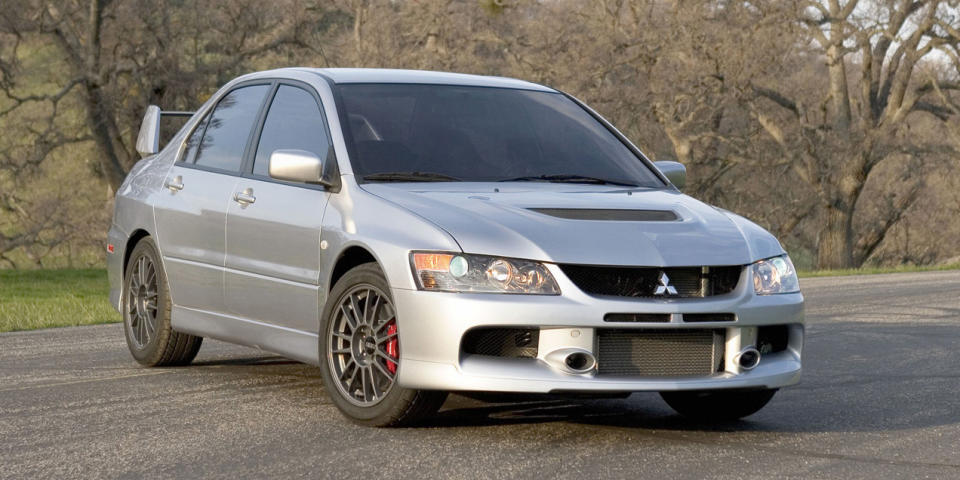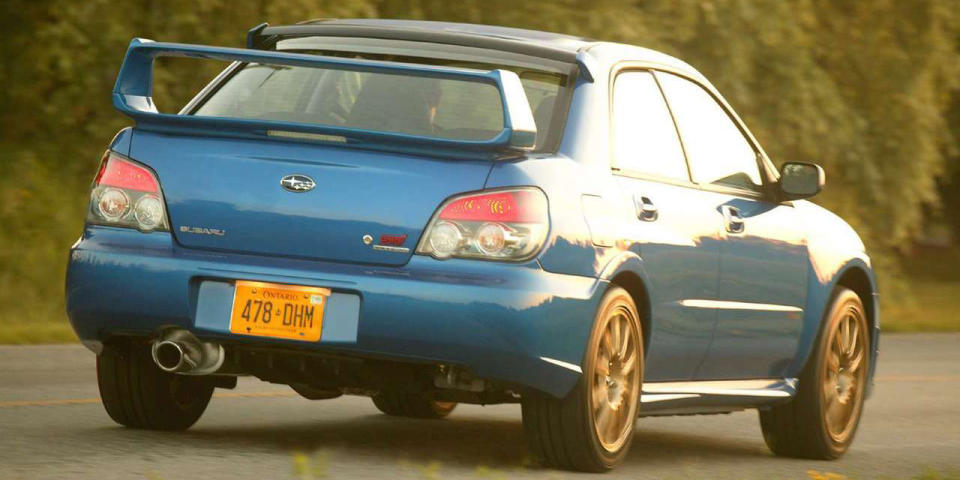Mitsubishi Evo IX MR vs Subaru Impreza WRX STI: Which Is Better?

From the December 2005 issue of Road & Track
"Air to mission control, bogie has been spotted, weapons are hot, awaiting confirmation to engage!"
The experience of piloting one of these tarmac-tearing, dirt-loving predators down a favorable road can often lead one's imagination astray. You suddenly feel like an advocate of rude awakenings, with a mission to complete every time you strap into the driver's seat. That mission: to seek and humiliate expensive sports cars that up to this point thought they owned the roads.
Throwing these two contenders into a ring together is like throwing the Incredible Hulk in with Juggernaut, and then telling them to have at it for a couple of rounds. Not only are they well-matched opponents, but each could also be arguably superior to the other in some way, shape or function. The Evo IX flexes a MIVEC-equipped (Mitsubishi Innovative Valve timing and Electronic Control) turbocharged 2.0-liter inline-4 now boasting 286 bhp and 289 lb.-ft. of torque. The power improvement comes from a revision of the turbo's compressor housing and a more aggressive muffler, and the power delivery is kept somewhat more linear through variable intake valve timing/phasing.

The 2.0-liter still feels rather anemic at the low end until muscularity sets in at 3500 rpm, turning it into a rip-roaring, torque-happy beast. We never seem to tire of that feeling that comes from 20 psi of oxygen-rich thrust, but must admit that for many, it tends to get bothersome in around-town stop-and-go traffic. The STI, on the other hand, does not dis appoint in that area. Power from the Subaru's larger 2.5-liter turbocharged flat-4 comes in early and seems to stay fairly linear where the Evo's power kicks in abruptly. There have been no power changes to the STI's aluminum powerplant, which still boasts an impressive 300 bhp at 6000 rpm with 300 lb.-ft. of torque, more than you ever really need on a daily basis anyway.
The Evo's dynamic characteristics not only make it predictable, but extremely confidence-inspiring, with Bilstein shocks that feel best suited for relatively well-paved roads. Gearing is slightly taller and more realistic than that of the STI, leading to less frequent shifting and certainty of which gear to choose when entering a turn. Braking systems are identical Brembo setups with nearly equally matched Bridgestone Potenza RE070s (STI) and Yokohama Advan A046s (Evo), which work well for both cars. The Evo's 6-speed manual transmission (MR only) is crisp and precise, making missed shifts rare. Turn-in is still quicker than the STI's with a new simple and ergonomic titanium-finished steering wheel to handle. Recaro bucket seats, now upholstered in Alcantara to reduce slipperiness, hold you in place under almost all conditions.
The STI's overall nature, though still great for track and autocross events, seems to favor a dirtier environment. The suspension not only has a longer range of travel, but is better suited for soaking up road irregularities (not to mention landings) than the MR's setup. The addition of a steering-sensor input communicating intentions to the DCCD (Driver Controlled Center Differential) all-wheel-drive system adds intelligence to the STI, with a new mechanical limited-slip center differential helping to transfer torque effectively. While it may be a different story off-road, we find ourselves less at ease through long sweepers due to the constant adjustments being made by the STI's anxious active-center differential. The interior of the Subaru is comfortable and well equipped, making it less industrial-like and more inviting. The leather-wrapped steering wheel has a better feel, and the gauges are visually more appealing. The seats provide great lateral support but don't share the same level of aggressiveness as the Evo's.

The race to one-up each other comes in the form of add-ons instead of overhauls, mainly because Subaru and Mitsubishi know what outstanding performers they already have. Some of the other facets not mentioned yet for the STI include a brand-new front end (think Tribeca) restyled to reflect the company's aircraft heritage. There are new slant ed bulbous headlights and cleaner taillight clusters too. A roof spoiler said to enhance stability graces the top of the rear window, and the underside of the car receives a new diffuser mounted aft of the rear wheels. Evo MR updates include a tweaked front fascia integrating foglights with minor changes to head- and taillights, a revised hollow-design carbon-fiber rear wing, body-colored vortex generators, lighter Enkei wheels, and aluminum pedals to match the MR's aluminum roof construction.
A victor in this rivalry is not easily determined. It really depends on what you as a driver want from your car. In my opinion, there is no car that will love you more than an Evo will. As a road warrior, its sharpness, directness, and aggressive yet forgiving nature leave the STI no choice but to step aside. One thing remains a given-compare the capabilities of this pair along with their costs, and there simply is no other competition.

 Yahoo Autos
Yahoo Autos 